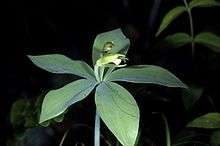Isotria medeoloides
Isotria medeoloides, commonly known as small whorled pogonia or little five leaves, is a terrestrial orchid found in temperate Eastern North America.
| Isotria medeoloides | |
|---|---|
 | |
| Scientific classification | |
| Kingdom: | |
| (unranked): | |
| (unranked): | |
| Order: | |
| Family: | |
| Subfamily: | |
| Tribe: | |
| Genus: | |
| Species: | I. medeoloides |
| Binomial name | |
| Isotria medeoloides | |
Distribution
The orchid's range is from southern Maine south to Georgia and west to southern Ontario, Michigan, and Tennessee. A population was found in Missouri in 1897,[2] but the plant is no longer believed extant there.[3]
It has always been considered a rare species, often legendarily so. It has been called "the rarest orchid east of the Mississippi."[4]
The plant's habitat includes hardwood and conifer-hardwood forests, where it is found in leaf litter along small "braided" intermittent streams. It native range includes the Appalachian Mountains and Great Lakes region.
Description
Isotria medeoloides is a rhizomatous herb producing a waxy gray-green stem up to about 25 centimeters tall. The gray-green leaves are up to 8.5 centimeters long by 4 wide and are borne in a characteristic whorl.
The flower has green and green-streaked yellowish petals measuring between 1 and 2 centimeters long.[5]
Conservation
The plant is listed as a threatened species by the U.S. Fish and Wildlife Service, having been downlisted from endangered status in 1994 as more populations were discovered and several were given protection.[3] It is listed as an endangered species by most states or provinces within its range.[6] There are about 104 populations known to exist, but most of these are small, containing fewer than 25 plants.[4]
The main threat to the species' existence is the destruction of its habitat.[4] Other threats include wild pigs, off-road vehicles, predation by deer and slugs, vandalism, and collection.[7]
Taxonomy
This orchid is sometimes confused with the common Indian cucumber (Medeola virginiana), which has similar whorled leaves and grows in similar habitat types. The species name medeoloides is a reference to this similarity.[4]
Anecdotal tales of the species only appearing at decades-long intervals do not appear to be supported by field studies. The plant can usually remain dormant for up to three years.[4]
Notes
- Treher, A.; Sharma, J. & Poff, K. (2015). "Isotria medeoloides". The IUCN Red List of Threatened Species. IUCN. 208. e.T64176265A65215480. doi:10.2305/IUCN.UK.2015-4.RLTS.T64176265A65215480.en.
- Small whorled pogonia. Archived 2010-05-28 at the Wayback Machine Missouri Conservationist.
- USFWS. Isotria medeoloides Five-year Review. October 2008.
- Isotria medeoloides. Archived 2010-12-15 at the Wayback Machine Center for Plant Conservation.
- I. medeoloides. Flora of North America.
- USDA Plants Profile
- USFS. I. medeoloides. Celebrating Wildflowers.
References
- Gleason, H.A. and A. Cronquist. 1991. Manual of Vascular Plants of Northeastern United States and Adjacent Canada. New York Botanical Garden, Bronx, New York.
- Radis, R.P. 1983. Endangered, Threatened, Vulnerable, and Rare Vascular Plant Species of the Delaware Water Gap National Recreation Area. U.S. Department of the Interior, National Park Service, Philadelphia, Pennsylvania.
